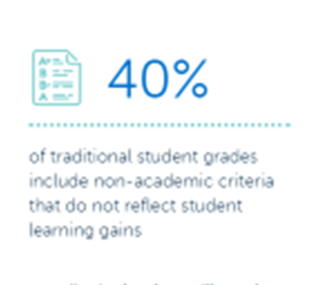- NJASA
- Curriculum Corner June 2022
-

Why Equitable Grading Policies Matter Morethan District Leaders May Think
 Course failure rates more than doubled during the pandemic, reducing student confidence in school and their chances of pursuing postsecondary education. But lack of learning isn’t the only driver of course failures. Up to 40% of traditional student grades include non-academic criteria that do not reflect student learning gains—including participation and on-time homework submission. As a result, traditional grading may inadvertently penalize underprivileged students who struggle to meet non-academic expectations.
Course failure rates more than doubled during the pandemic, reducing student confidence in school and their chances of pursuing postsecondary education. But lack of learning isn’t the only driver of course failures. Up to 40% of traditional student grades include non-academic criteria that do not reflect student learning gains—including participation and on-time homework submission. As a result, traditional grading may inadvertently penalize underprivileged students who struggle to meet non-academic expectations.To improve student grades and propel students toward postsecondary success, district leaders will need two approaches:
- Deploy a comprehensive learning recovery strategy
- Adopt equitable grading practices this year
While the first is foundational to minimizing the number of course failures moving forward, don’t let the second step remain unaddressed. Equitable grading is a highly effective yet underutilized strategy that is proven to improve student grades and minimize grading biases. In this practice, districts remove non-academic performance from final grades so that GPAs only reflect learning mastery.
Here are three reasons why equitable grading is particularly essential this year:1. Test-optional admissions place a higher premium on student grades
About half of colleges and universities state that they will likely maintain test-optional policies until at least 2023. As a result, passing grades and solid GPAs are now more important for college admissions than in previous years.
Because colleges are placing greater weight on transcripts, district leaders must not let non-academic components like participation or homework compliance stymie students’ chances of attending a postsecondary institution. By redesigning grading policies to reduce subjectivity and increase academic accuracy, districts can improve students’ chances of being eligible and competitive applicants to postsecondary institutions.
2. Equitable grading policies help unmask students’ underlying learning gaps
Transitioning to more equitable grading policies means a sharper focus on academic mastery. This provides teachers with more accurate data for determining which content to prioritize and accelerate throughout the school year.
Including subjective elements like completion or timeliness in grades paints an inaccurate picture of what students have and haven’t learned in core classes. For example, a student who scored a 75% in Algebra may underperform in core math skills but never miss turning in their homework on time. On the other hand, schools may inadvertently penalize students with low grades who are unable to participate in traditional ways due to challenges at home—regardless of whether they understand the material. Without an accurate picture of students’ actual learning, academic progress could be delayed.
3. Equitable grading practices help signal and reinforce districts’ DEIJ values
Districts who want to take bolder action toward diversity, equity, inclusion, and justice should reexamine their grading policies to ensure low-income students and students of color are not inadvertently penalized by outdated practices.
Equitable grading helps keep student evaluations and scoring more objective and less prone to unconscious biases. For example, teachers may unintentionally let non-academic factors—like student behavior or whether a student showed up to virtual class—interfere with their final evaluation of students. By training teachers to remove the non-academic factors from their grading practices and recognize when personal biases manifest, districts can proactively signal a clear commitment toward DEIJ.
To help districts transition towards equitable grading, EAB has developed an Equitable Grading Audit for district leaders. Download the audit to begin assessing and adjusting your grading policies moving forward.



